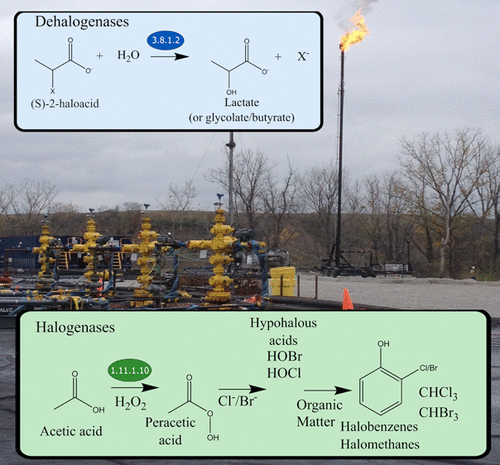当前位置:
X-MOL 学术
›
Environ. Sci. Technol. Lett.
›
论文详情
Our official English website, www.x-mol.net, welcomes your feedback! (Note: you will need to create a separate account there.)
Hydraulically Fractured Natural-Gas Well Microbial Communities Contain Genomic Halogenation and Dehalogenation Potential
Environmental Science & Technology Letters ( IF 10.9 ) Pub Date : 2019-09-16 , DOI: 10.1021/acs.estlett.9b00473 Morgan V. Evans 1 , Andrew J. Sumner 2 , Rebecca A. Daly 3 , Jenna L. Luek 4 , Desiree L. Plata 2, 5 , Kelly C. Wrighton 3 , Paula J. Mouser 4
Environmental Science & Technology Letters ( IF 10.9 ) Pub Date : 2019-09-16 , DOI: 10.1021/acs.estlett.9b00473 Morgan V. Evans 1 , Andrew J. Sumner 2 , Rebecca A. Daly 3 , Jenna L. Luek 4 , Desiree L. Plata 2, 5 , Kelly C. Wrighton 3 , Paula J. Mouser 4
Affiliation

|
Organohalides are routinely detected in fluid produced from hydraulically fractured oil and natural-gas wells, yet the origin and fate of these compounds remain largely unknown. Because few organohalides are disclosed as fracturing fluid additives, one suspected formation mechanism is the reaction of geogenic halides oxidized by injected additives with natural or anthropogenic organic carbon. However, the potential role of microorganisms in organohalide cycling is currently unknown. Here, we uncover the microorganisms and enzymatic systems that contribute to organohalide transformations during hydraulic fracturing through nontarget organohalide chemical analysis and metagenomics. Twenty organohalide compounds were identified in fluid samples produced from two Marcellus Shale natural-gas wells, comprising five structural classes. Genes encoding halogenation and dehalogenation mechanisms were identified in metagenomes assembled from produced fluids collected from four Appalachian Basin natural-gas wells. Metagenomic results show the presence of non-heme chloroperoxidases, enzymes that generate peracetic acid, which can react with dissolved halides to form highly oxidizing hypohalous acid, a halogenation agent for geogenic or anthropogenic organic matter. Microbial organohalide transformation/mineralization could proceed through hydrolytic dehalogenation, with enzymes inferred to operate on haloacetates, haloacids, and haloalkanes of varying carbon chain lengths, some of which are present in these wells. These results indicate that microorganisms may play an underappreciated role in direct and indirect organohalide transformations in hydraulically fractured oil and gas systems.
中文翻译:

水力压裂的天然气井微生物群落具有基因组卤化和脱卤的潜力
通常在从水力压裂的油井和天然气井中采出的流体中检测到有机卤化物,但这些化合物的来源和命运仍然未知。因为很少公开有机卤化物作为压裂液添加剂,所以一种可能的形成机理是被注入的添加剂氧化的地质卤化物与天然或人为有机碳的反应。但是,目前尚不清楚微生物在有机卤化物循环中的潜在作用。在这里,我们通过非目标有机卤化物化学分析和宏基因组学,揭示了在水力压裂过程中有助于有机卤化物转化的微生物和酶系统。在两个Marcellus页岩天然气井生产的流体样品中鉴定出20种有机卤化物,包括五个结构类别。在从四个阿巴拉契亚盆地天然气井收集的采出液组装而成的元基因组中,鉴定出了编码卤化和脱卤化机理的基因。元基因组学结果表明,存在非血红素氯过氧化物酶(一种生成过氧乙酸的酶),该酶可以与溶解的卤化物反应形成高度氧化的次卤酸,次卤酸是地源或人为有机物的卤化剂。微生物有机卤化物的转化/矿化作用可以通过水解脱卤来进行,据推断这些酶可作用于碳链长度不同的卤代乙酸盐,卤代酸和卤代烷烃,其中有些存在于这些孔中。
更新日期:2019-09-16
中文翻译:

水力压裂的天然气井微生物群落具有基因组卤化和脱卤的潜力
通常在从水力压裂的油井和天然气井中采出的流体中检测到有机卤化物,但这些化合物的来源和命运仍然未知。因为很少公开有机卤化物作为压裂液添加剂,所以一种可能的形成机理是被注入的添加剂氧化的地质卤化物与天然或人为有机碳的反应。但是,目前尚不清楚微生物在有机卤化物循环中的潜在作用。在这里,我们通过非目标有机卤化物化学分析和宏基因组学,揭示了在水力压裂过程中有助于有机卤化物转化的微生物和酶系统。在两个Marcellus页岩天然气井生产的流体样品中鉴定出20种有机卤化物,包括五个结构类别。在从四个阿巴拉契亚盆地天然气井收集的采出液组装而成的元基因组中,鉴定出了编码卤化和脱卤化机理的基因。元基因组学结果表明,存在非血红素氯过氧化物酶(一种生成过氧乙酸的酶),该酶可以与溶解的卤化物反应形成高度氧化的次卤酸,次卤酸是地源或人为有机物的卤化剂。微生物有机卤化物的转化/矿化作用可以通过水解脱卤来进行,据推断这些酶可作用于碳链长度不同的卤代乙酸盐,卤代酸和卤代烷烃,其中有些存在于这些孔中。



























 京公网安备 11010802027423号
京公网安备 11010802027423号